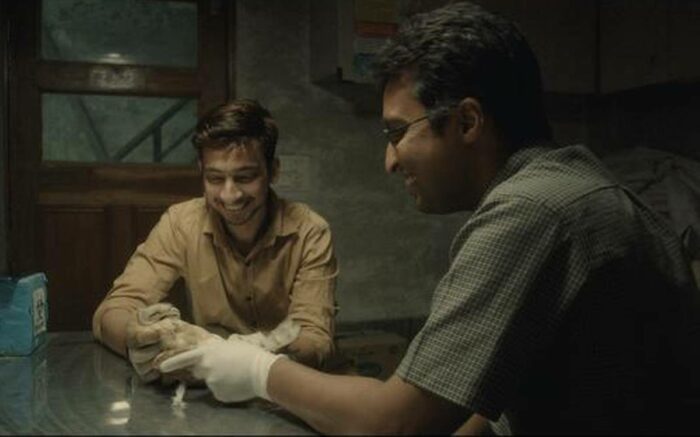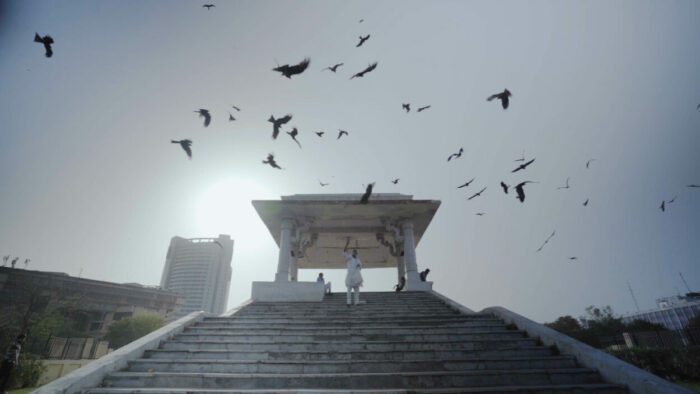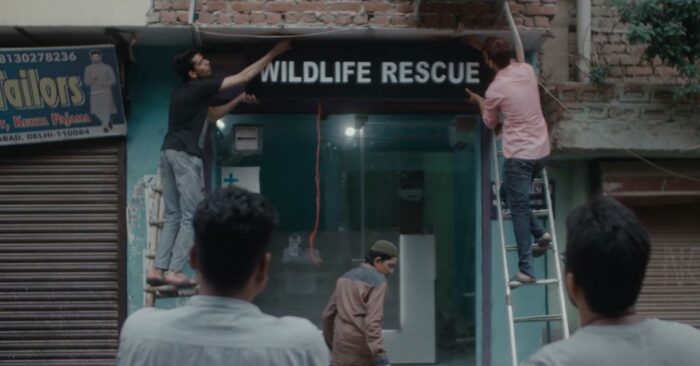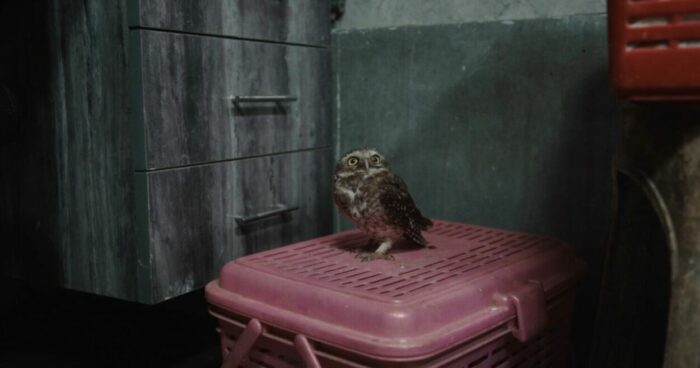“Nature will always find a way to absorb waste. Think of the city as a stomach. The kites are like the microbiome of the gut. They eat away our waste.”
Nominated for Best Documentary at the 95th Academy Awards, the mesmerizing All That Breathes is a stunning tribute to human empathy and perseverance. Directed by Shaunak Sen with masterful cinematography, amplified sensitivity, and editorial precision, the film opens with a horrifying shot of rats scattering about an abandoned lot somewhere in New Delhi. Like many of the film’s interstitial images, this scene is both ancillary and metaphorically central, a visual testament to the filth at the margins of the natural environment. Rats, a terrestrial sibling to kites, are a fitting choice to introduce New Delhi: considered the scourge of any urban landscape, they sustain themselves on the city’s jettisoned toxic waste. And yet, they also serve a fundamental role and purpose. This Darwinian dualism is at the heart of this documentary, imbuing it with simultaneously sanguine and saturnine thematic intensities.
Throughout, we hear lots of speculations about the state and condition of New Delhi—including talk about how the air changed so drastically it altered the city’s metabolism. Mirroring these monologues, which liken the city to a stomach, All That Breathes is relentlessly fascinated with the gastrointestinal underbelly of modern human society. It is unafraid to observe and subsist within its minute metabolic movements and developments. It views mutation as not freakish but mandatory—understanding that when the nutritional composition of any ecosystem deteriorates, its fauna and its flora will follow suit, adapting and evolving in tow.
While the film’s macro-fascination incorporates all corporeal creatures, kites are the prevailing interested. We watch kites being nursed back to health by a ragtag team of dedicated bir rescuers/veterinarians (Nadeem Shehzad, Mohammad Saud, and Salik Rehman). Little is explicitly stated about this team’s actual qualifications or overarching/long-term goals. We just know they care deeply about the urban ecosystem and know all too well the perils of surviving amidst Delhi’s contaminated city streets and skies.
We also know they are willing to put life and limb on the line to save helpless creatures. We see them wading through rivers, carrying stacks of wooden boxes holding sick/wounded/paralytic kites, and spending every waking moment rehabilitating unhealthy birds whom had fallen from the sky. We watch them eating dinner, arguing with their wives, and playing cricket in their dimly lit, claustrophobic workspace. And we listen to them dreaming of better equipment and technology, like a conveyor belt, that would allow them to heal kites in a quick, assembly-line fashion.

Their passion for kites is a rarity. After all, many in Delhi view kites as a filthy nuisance. These men, however, see their spiritual worth and utility. They care deeply for the birds with genuine concern. They celebrate their sentient kinship with the “alien reptile”-looking avian specie. And they’ve devoted their lives to conserving as many as possible, despite the onslaught of disease and death due to Delhi’s overwhelming industrial pollution.
The kites have thrived by default of their scrappiness, but they’ve also become sickened by their craftiness. Their resourceful re-appropriation of cigarette buttes as insect repellent is the perfect encapsulation of this paradox. While they learned to weaponize waste for competitive gains, they also inadvertently became harmed by their exposure to human-manufactured products and carcinogens. Given New Delhi’s overpopulation and pollution problems, the kite population exploded in Delhi due to their capacity to digest city waste. Lots of the scenes are dedicated to capturing kites in everyday action. We see them hovering and circling over trash sites and dumps. We see them diving throughout the sitting to snatch trash, bifocal glasses, and rotting meats. We even listen to our team of bird rescuers estimating the amount, in tons, of waste they eat each month (they surmise fifteen tons, in total).

One of the vets wonders how much weight Delhi would be burdened by without the kites’ natural disposal methods. It’s a very generous and well-thought-out rhetorical question. However, another vet responds by noting that before the kites populated the skies vultures were everywhere. This offhanded retort is emblematic of All That Breathes primary thesis—i.e., that the world defines the function of species as much as species define the function of the world. Contrary to anthropocentric notions of autonomy, it is the ecosystems themselves that organically calibrate and define and balance sentient life, shaping every single creature in their pursuit of environmental equilibrium.
One might argue this thesis encompasses much more than kites and the animal kingdom. It even extends to the conservationists and the city itself. Delhi is shown as an inhospitable city of scraps, detritus, and effluvium—exposed as a cramped, clustered, vermin-infested urban wasteland where rats and wild boars roam freely, sewage gurgles and seeps perennially, and sectarian violence brews as routinely as the monsoon season. Delhi is depicted as an anti-utopia where large swaths of natives live like parasites and refugees—siphoning energy, water, and food from wherever they can to get by; defending their property from jingoistic marauders hellbent on weeding out the proverbial vermin minorities; rummaging and repurposing the carrion and discarded artifacts of society to maintain life.

Like the city’s songbirds, who we learn recently began to sing at a higher pitch to communicate over traffic noise, advantageous mutation and savvy ingenuity are a necessity of everyday life in Delhi. Our bird rescuers deal with constant infrastructural setbacks and issues: rolling blackouts, a meat grinder with a broken plug, a defective freezer, sewer water inundating their workspace/car garage during heavy rains, etc… Even when their daily devices and patchwork technology are working properly, the habitat is a hodgepodge of debris and miscellany salvaged from recycled and decommissioned goods. Even the contraptions and technologies are mutations and offshoots, reinventions of decaying rubbish and remnants.
Nothing seems to come easy for the inhabitants of New Delhi. Our team of kite enthusiasts and scientists lead with quiet determination, sober gumption, a gloomy air of exhaustion, and a patient sense of exigency. When foreign funding is briefly rejected and the financial outlook turns grim, everything seems to teeter on total collapse. But like the songbird altering its frequency, we witness the small team subtly adapting. In this case, they wield the power of media via a NY Times article to gain enough traction to procure a miracle line of last-second funding. By the hair on their chin, money trickles in and they get to continue their modest vocation of tending to ill and injured kites.
Amidst these obdurate victories is a coterminous ambiance of cynicism and fatigue. A palpable frustration and a generalized sense of dread and anxiety lurk in the background of every scene, even the moments of humor and levity. Despite the film’s resolve to uncover beauty beneath the muck and sludge of decaying urban topographies, there’s no denying that putrescence and pollution weigh heavy on the shoulders of the average soul. For every platitude about the universal kinship that persists between all that share the same pervasive air, there’s an equally dystopian undercurrent of foreboding.

One can feel that this mode of rescue and rehabilitation is not very sustainable and far from ideal. The world is not healthy, and its rate of decline seems to be accelerating more rapidly than the pace of evolutionary mutation. There’s a sense that many of the living creatures are on the brink of succumbing to proliferating cancers, and that Delhi, by default, is on the brink of toppling into complete chaos—of becoming a cesspool of urban flotsam, western jetsam, and ethnoreligious fractiousness.
This disquieting and ominous presentiment infiltrates all aspects of life, including causal banter. We listen to the men conjecturing science fiction scenarios, wondering whether there’s enough water to hypothetically cover up all the earth’s land, and debating the possibility of engaging in nuclear warfare with Pakistan. We hear their latent anxieties about becoming victims of a nuclear holocaust. We hear them envisioning a world raft with human corpses, and guessing how long the kites would have to wait for the post-nuclear radiation to subside so they could begin scavenging our human remains. We hear their laments about Delhi, likening the city to a gaping wound. We hear news reports and radio broadcasts about protests and new refugee regulations and deadly city-street clashes and brutal attacks on Muslim minorities.
Even the perfunctory grumbling is quite depressing and bleak. In one subtly haunting scene, the co-leader of the sibling-led rescue team, Nadeem, explains how he grew up admiring Darwin and Newton but now exerts his daily energy on Excel sheets. His brother, Saud, is a bit more optimistic though also beleaguered and weary, notes that their fight to save kites is a symptom of something much larger going on. The two siblings appear to be best friends and lifelong partners, but they are also prone to erupting at one another from time to time. Their rows speak more of desperation than anger or failed camaraderie. It’s a humble, grueling lifestyle they upkeep. When they do succeed, their celebration is as decadent as sharing a cheap convenience store ice cream. When they fail, they are stuck sweaty and demoralized, forced to bury piles of dead birds.

What drives them to continue clawing and scrapping, much like the kites, is somewhat of a mystery. This sentient steadfastness and moral indefatigability is the heartbeat of the documentary. As literal as the narration can be, there’s a mystical element to the proceedings. The drudgery of these men takes on a saintly air that feels poetic and metaphysical, elliptical and indicative of all that’s good in humanity. It’s somewhat telling that the rescue’s cofounders came to love science via stories their mother told them about ghosts and holy spirits. After all, the world All that Breathes celebrates is a world where scientific endeavors bear theological significance—where spiritual truths inhabit corporeal anguish and fantastical enchantments reside embedded in the morass of quotidian mundanities.
To show the latent splendors of life, All That Breathes interpolates intermittent shots of peripheral creatures surviving in the background of the city. These images become transcendental—moments of such otherworldly beauty they feel like instances of magical realism. Whether filming a snail crawling in front of blurry flames or a gecko camouflaged on a wall or a pair of claws perched on wood or horses trotting over a wooden bridge, the complexities and disparities of living organisms on display become exquisitely evident.
This rich diversity is made all the more apparent by the beguilingly emergent process in which camouflaged creatures blend and emerge in the frame. It feels as if the film is deliberately blurring spatial and geographical and existential boundaries—showing everything as ensconced in the same plenum. The reptiles and insects and mammals and rodents are depicted with such disorienting proximity that the entire world simply feels immersive and entwined. Everything is foregrounded and hidden — constantly in flux and ever-commingling. This is a world where even the thresholds of dreaming and reality start to dissolve together — where one of the team member’s night terrors invoke the horror of cardiac arrest followed by a vision of kites flying out of his cold, lifeless chest.

The net effect is a marbling of the boundaries and spatial discrepancies of everything. Very slyly, the mystical and the pragmatic become enmeshed along with the civilized and the wild, the feral and the tamed. By showing the teeming immensity of wildlife in the city, All That Breathes reinforces the vital importance of protecting all species regardless of relevance or occupation. It thus specifically honors those overlooked and surviving within the margins. It pays tribute to the integrity of rats and termites and kites and impoverished/ostracized communities. Echoed throughout All That Breathes is the sentiment that all things deserve the right to existence equally, even if nature is cruel and deadly:
“One shouldn’t differentiate between all that breathes. Trees and fungus and vegetation and supernatural worlds were all mixed for her.”
Perhaps the true power of the documentary is that it somehow manages to make axiomatically corny beliefs affect you on a visceral level. The musings may be filled with quixotic clichés, but their worldliness and obstinacy will take your breath away. Why exactly the platitudes work so well is somewhat hard to say. Perhaps the real reason lies in the phenomenal beauty captured onscreen—the way Delhi’s sensory and sentient milieu morphs and mingles in novel and gorgeous ways. This is truly a work of cinema as an empathy machine—forming images of striking sublimity that are so unyieldingly stunning and so thematically meaningful they belie the sullied dynamics of their grim urban-industrial settings.


